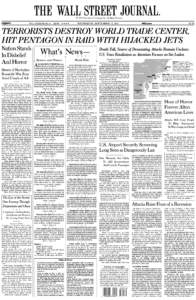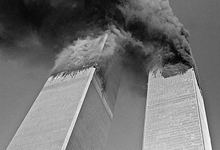There’s an old joke that refers to newspapers as “the daily miracle.” But one edition a decade ago, assembled by Wall Street Journal staffers on Sept. 11, 2001, was truly miraculous.
First, it was astounding that the Journal could be published at all, given that its newsroom and corporate headquarters were directly across the street from the World Trade Center. Hell began to rain down on the Journal’s doorstep as most reporters and editors were filtering in for what they thought would be a normal Tuesday. The Journal’s building was evacuated just before 9:30 a.m., about 45 minutes after the first plane smashed into the north tower.
Moreover, the edition that reached all but 15 percent of the Journal’s 1.8 million readers on Sept. 12 was a masterpiece of American daily journalism, much greater than “something for the scrapbooks,” as then-Managing Editor Paul Steiger feared could have resulted.

The Sept. 12, 2001, edition of the Journal carried a six-column headline for the first time since Pearl Harbor. (Click on the image to see the full page.)
That newspaper was filled with “comprehensive and insightful coverage, executed under the most difficult circumstances,” as the Pulitzer Prize Board said in awarding the Journal the 2002 Pulitzer for Breaking News Reporting.
The staff did that exceptional work despite being cut off from “most of the things that reporters and news organizations count on to allow them to deliver extraordinary work, under high pressure,” Steiger said. “People had to make their decisions on the fly.”
The staff’s reactions that day were a form of improvised battlefield journalism, complete with command posts, forward positions and endangered scouts — which suggests the third miracle.
“It seemed impossible that we wouldn’t have lost someone,” Steiger said in a telephone interview, recalling a couple of anxious days until everyone had been accounted for.
Demanding leadership, and a key decision
Like most successful wartime operations, this one depended on the rapport that leaders have with the troops and good command decisions about deployment.
“We were all iron filings being magnetized in the same direction,” Steiger said from his current office in Lower Manhattan, where he is editor-in-chief and president of ProPublica. (The Journal, purchased in 2007 by Rupert Murdoch’s News Corp., has moved the paper’s newsroom to Midtown.)
That magnetizing force, of course, doesn’t materialize automatically. The Journal had forged it in everyday, non-crisis situations. In a publication focusing on Steiger’s management style, then-Assistant Managing Editor Cathy Panagoulias described him as “always very clear in demanding a level of excellence one step above what you think you can provide.”
“So on Sept. 11,” she said, “literally hundreds of staffers around the world did what we know he wanted at a level one step above what any of us thought possible.”
Within minutes of the first tower being hit, Steiger made one critical decision, without which there may have been no Sept. 12 Journal.
Steiger and Jim Pensiero, then an assistant managing editor of the paper, had begun that day early, with an 8:30 a.m. meeting about the newsroom budget, according to a remarkable, diary-like memo that Pensiero later wrote to chronicle the day.
It was not yet 9 when the two men rushed to the newsroom’s east-facing window. As they watched three high floors of the north tower engulfed in flames – not yet knowing the cause — Steiger “asked me if we had another place to produce the Journal in case we were forced to evacuate,” Pensiero wrote.
Pensiero, who also was an expert in the production system, had been helping to establish a training center at the parent company’s South Brunswick, N.J., offices, about 50 miles southwest of lower Manhattan. A small backup newsroom recently had been set up there, though it was never envisioned as a replacement for the main office, and Pensiero wasn’t sure if it was ready to operate on any scale.
He told Steiger that the training center might work if editors and graphic artists could get there quickly and technicians could link it with other Journal operations. At Steiger’s direction, Pensiero used the still-working phones to line things up with South Brunswick.
The two editors felt the impact on the second tower at 9:03 a.m. – this time shaking the Journal newsroom violently – and it became clear that a plane had caused it. Steiger headed down to the street to advise arriving staffers to head for South Brunswick, and asked Pensiero to compose an email to top editors and the Washington bureau. Pensiero hit the send button at 9:23, just as a security guard showed up to press him to evacuate.
Orders from the Upper West Side
Pensiero found his way to a ferry, which turned out to be the last one across the Hudson, and watched the twin towers collapse behind him. When he arrived at the South Brunswick office just before noon, he determined that the paper had a good chance of being produced there and was encouraged by the number of personnel assembling in the office. Still, “I had no idea where Paul Steiger was, let alone the other top editors of the paper.”
Some staffers feared the worst. The Upper West Side apartment of Byron “Barney” Calame, Steiger’s key deputy managing editor, became the main outpost for top editors who determined that they couldn’t get to New Jersey.
They established communications with Pensiero and the Journal’s Washington office and other bureaus, using Calame’s two PCs and four BlackBerries among all of the editors. “Email turned out to be the most reliable way to stay in touch,” Calame said in an interview. Those editors, too, waited for word about their managing editor.
Steiger had had a series of close calls outside the Journal building as he sought out staffers. He fled with the crowd after the first tower collapsed. “I remember saying to myself, ‘You don’t die of smoke inhalation in the open air’,” Steiger said. ”It’s not always true, I knew, but it was a nice thing to tell myself at the time.” Then the second tower collapsed, repeating the terror.
His best blue suit dusted white, he made his way by foot and bus to his apartment on the Upper East Side, emailed Pensiero at 1 p.m. and called Calame. “I say, ‘Hey, Barney, it’s Paul,’ and he starts to cry. He thought I was dead,” Steiger recalled. “I didn’t realize I was lost; I thought everybody else was lost.”
Pensiero emailed the Journal news bureaus the story budget at 1:38 p.m., drawing on story lines proposed by then-National Editor Marcus Brauchli, who was working from his home, and other bureaus around the country. Soon, Steiger made it by car across town to Calame’s West Side outpost.
The next key decision by Steiger created a new challenge for his subordinates. Considering the production pressures, Journal designers in South Brunswick proposed using the then-standard layout of one-column headlines on the front page, featuring only three stories.
“I wanted to put a six-column headline on Page One,” said Steiger. “If ever you were going to put a six-column head on a story, this was the day.” Luckily, he said, page designer Joe Dizney had found his way to the Journal’s Midtown advertising office and had access to a Mac. “In 15 minutes, he did it; I looked at it and it was great.”
It was the paper’s first banner headline in 60 years; the previous time was when the paper reported the Pearl Harbor attack.
The final edition’s headline this day would say: “TERRORISTS DESTROY WORLD TRADE CENTER, HIT PENTAGON IN RAID WITH HIJACKED JETS.” Below it, six stories were slotted, including two detail-packed roundups, an analysis on lax airport security, and a piece on recessionary fears.
The sixth story was a first-person account by then-Foreign Editor John Bussey, who had been on the streets near ground zero for most of the day.
‘The Eye of the Storm’
Despite the remarkable balance of the stories on that page, Bussey’s riveting and graphic first-person story, headlined “The Eye of the Storm: One Journey through Desperation and Chaos,” is what many Journal readers remember most about the Sept. 12 edition.
With a phone in his hand but no notebook, Bussey had made his way from the Journal office to the street about the same time as Steiger and Pensiero, at one point pulling a muscle, he recalled in an interview, and impeding his escapes from the imploding buildings.
He absorbed the horror around him, “formulating in my head what I was going to say if I got the chance.” Eventually, he made it across the Hudson on a private power boat and to South Brunswick by cab.
“At about 7 p.m., a limping John Bussey arrived and asked if we’d be interested in a first-person account,” Pensiero recalled in his memo. Sure, Pensiero replied, alerting special sections editor Lawrence Rout, who filled in as Page One editor that day. From the West Side, Steiger signed off on the idea.
“I just started typing. In a way it was just like any other day, at least at that point,” Bussey said. “Pensiero was at my shoulder saying, ‘If we’re going to get anything in the paper I’m going to need your copy right now’.”
His story began:
If there’s only one sight I’ll remember from the destruction of the World Trade Center, it is the flight of desperation – a headlong leap from the top-most floors by those who chose a different death than the choking smoke and flame.
Bussey’s account, “to me, is still the single best thing I’ve ever read on what it really felt like that day,” Pensiero, now a Journal deputy managing editor, said in an email.
The image that Bussey opened with — and Paul Steiger himself witnessed — still haunts Steiger’s nightmares. “It’s something,” he said, “that you just don’t forget.”
Roy Harris is the author of Pulitzer’s Gold: Behind the Prize for Public Service Journalism. A Wall Street Journal reporter and editor from 1971 to 1994, he currently is editorial director of CFOworld.com. His account of lessons from the New York Times “Portraits of Grief” 9/11 coverage ran on Poynter.org on Aug. 30.








Comments